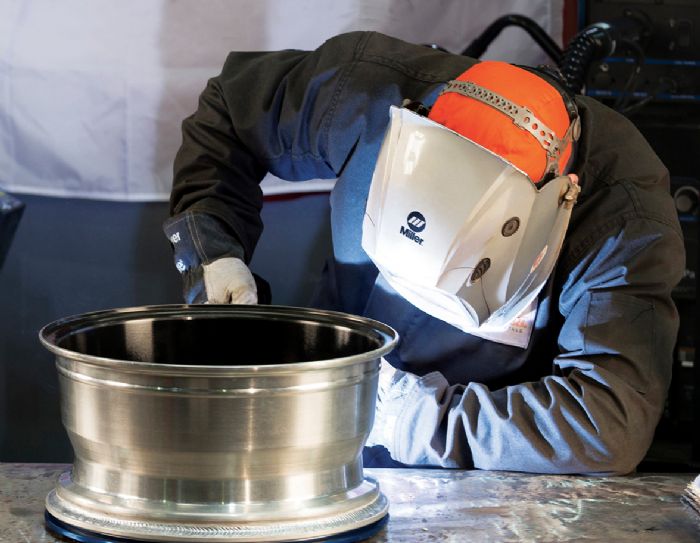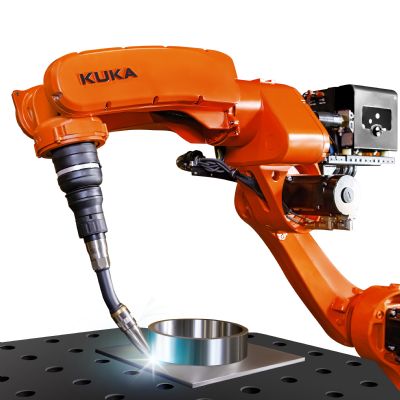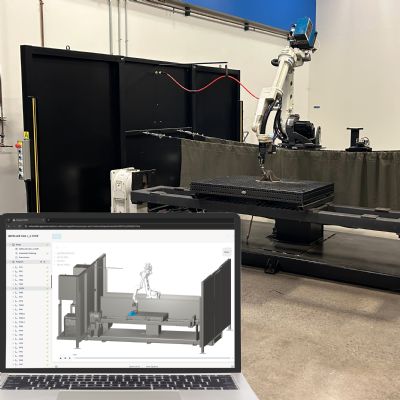To begin preparing for aluminum welding, thoroughly wipe the surface of the workpiece material with a clean cloth and a solvent, such as acetone, that cleans well and can effectively degrease the material. When using flammable liquids such as acetone, take care to work in an area away from the weld cell to avoid the risk of fire. Never use any liquid containing chlorine to clean aluminum, as chlorine becomes toxic when exposed to the heat of the welding arc.
Using a stainless-steel brush or grinding wheel dedicated to the purpose of cleaning aluminum, brush or grind the surface to remove the oxide layer. Because the oxide layer will start forming as soon as the exposed aluminum comes in contact with air, perform this step as close as possible prior to welding.
Although it isn’t necessary, after removing the oxide layer the operator can wipe down the surface with a clean cloth and acetone to remove any shavings.
Equipment, Consumables, and Technique
When gas-metal-arc welding (GMAW) of aluminum, the soft aluminum welding wire is subject to deformation and wire shaving during feeding. To prevent this, take care to use the proper equipment and consumables. In addition to a power source specifically designed for welding aluminum, U-grooved drive rolls and non-metallic inlet guides for the wire feeder help ensure good weld quality. These components provide smooth wire feeding and prevent wire shaving. Welding operators should set the lightest drive-roll tension that will effectively feed the wire.
Use a push-pull welding gun and a non-metallic Teflon liner, along with contact tips designed specifically for welding aluminum. If these contact tips are not available, use a standard copper contact tip with a bore diameter approximately 10 percent larger than the wire diameter, to reduce wire shaving while still providing the appropriate electrical conductivity to create a stable arc.
GMAW settings for aluminum will vary with the diameter of welding wire being used, as well as the thickness of the aluminum base material. Consult the filler-metal specification sheet for parameter settings--amperage, voltage and wire-feed speed.
To gain consistent arc characteristics, shield aluminum welds with argon or an argon-helium gas mix. Note that the addition of helium provides greater penetration and a wider bead profile when used on thicker sections of aluminum. However, helium, more expensive than argon, also can create a slightly less stable arc. The needs of the application will determine whether helium’s additional cost is worthwhile compared to changing the weld-joint design or making other adjustments.
Skilled welders employ specific techniques on aluminum. When welding with solid aluminum wire, they use a push angle that creates a wide weld bead and good tie-in at the toes of the weld. Compared to steel, aluminum’s greater thermal conductivity may require not only higher current or voltage, but also faster travel speeds. Because of this, the term “hot and fast” is often used to refer to aluminum welding.
Filler-Metal Considerations
Filler-metal selection for aluminum depends on the specific workpiece alloy and the desired properties of the finished weld. Consider these performance factors when selecting the filler metal:
- Crack sensitivity
- Weld strength
- Weld ductility
- Corrosion resistance
- Elevated service temperatures
- Color match after anodizing
- Post-weld heat treatment
- Toughness
Filler-metal manufacturers offer selection charts that can help match specific aluminum alloys to the proper filler metal, based on these factors. That said, welding wires designated as Type 4043 and 5356 are among the most common options. Type 4943 filler metals also offer some unique characteristics that make them a desirable substitute for Type 4043 products.
Type 4043 aluminum filler metals will develop a fluid weld pool, thanks to the addition of 5-percent silicon. This improves wetting action, or flow into the joint, helping to minimize cracking and reduce the need for extra post-weld cleaning. Type 5356 filler metals contain magnesium, which increases weld toughness and strength; however, it also creates more smut (black soot) at the toes of the weld that will require post-weld cleaning.
Using Type 4943 weld wire rather than a Type 4043 wire will result in higher weld strength (due to additional magnesium), with comparable weldability and crack resistance.
Parting Thoughts
Welding operations, when working with aluminum, can benefit from establishing some basic best practices. Start with ensuring cleanliness and proper material preparation. Then, always follow manufacturers’ recommendations for power-source and weld-gun setup, and consumable installation, to optimize weld quality.
And, be sure to follow recommended safety instructions. MF
View Glossary of Metalforming Terms
See also: Hobart Brothers Co.
Technologies: Materials, Welding and Joining
Comments
Must be logged in to post a comment. Sign in or Create an Account
Jagtar Singh K. SUN, APR 12, 2020 @ 1:17 AM
Very well explained , thanks for updating our knowledge Thanks







 Aluminum’s high thermal conductivity adds to its appeal. It can be used for applications such as radiators and heat exchangers, and at a lower cost than copper, for example.
Aluminum’s high thermal conductivity adds to its appeal. It can be used for applications such as radiators and heat exchangers, and at a lower cost than copper, for example. 

